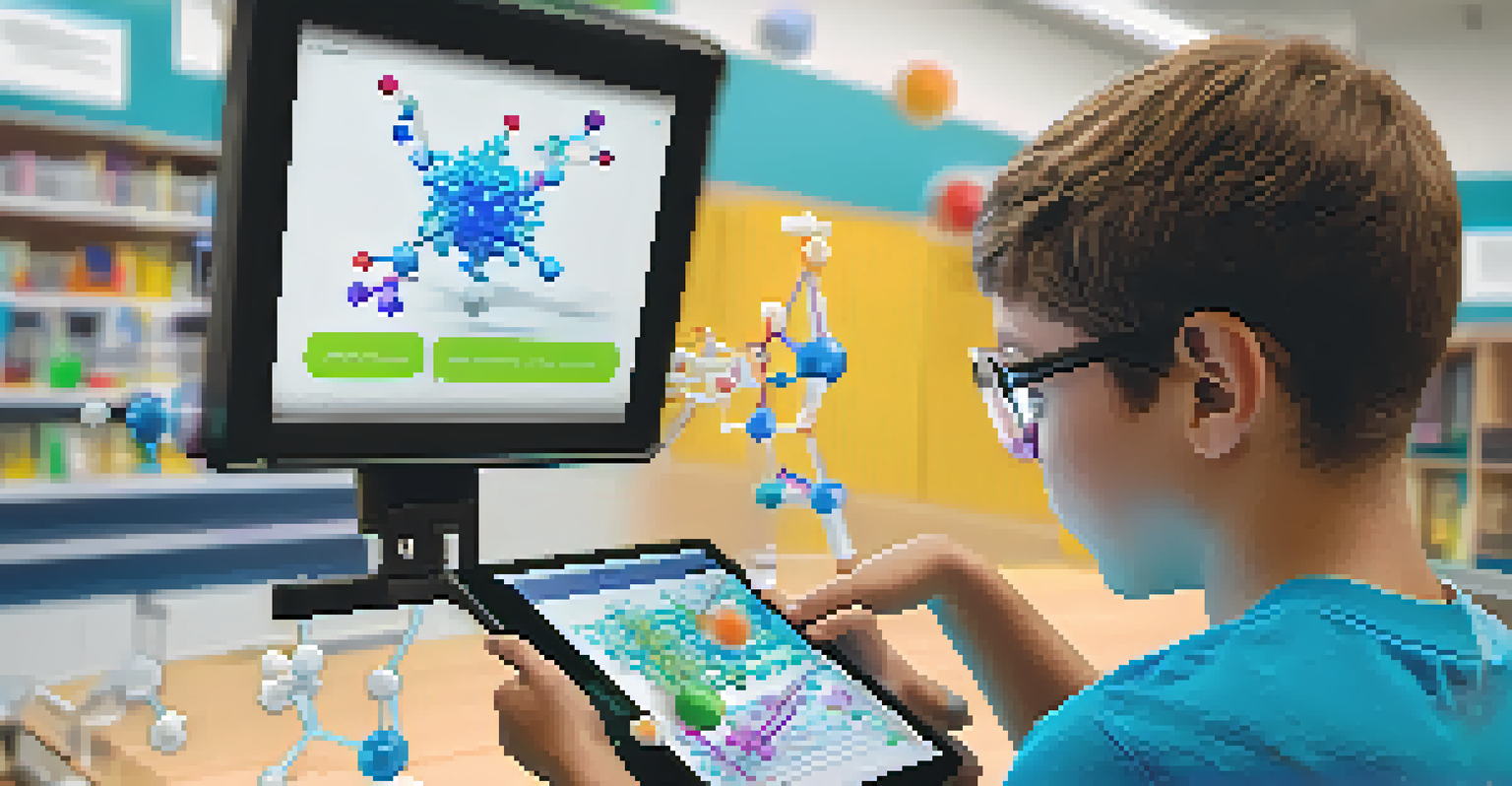Exploring the Use of Augmented Reality in STEAM Education

Understanding Augmented Reality in Education
Augmented Reality (AR) offers interactive experiences by blending digital content with the real world. In education, this technology transforms traditional learning methods, making subjects like science and math more engaging. For instance, students can visualize complex concepts, like the solar system, by using AR apps that project planets into their classroom.
Augmented reality is an innovative technology that can enhance learning experiences by providing immersive and interactive content.
This integration of AR not only captivates students' attention but also caters to various learning styles. Visual learners benefit from seeing information presented in 3D, while kinesthetic learners can interact with digital elements. Overall, AR promotes a more inclusive learning environment where every student can thrive.
As educators explore AR, they are discovering its potential to foster creativity and critical thinking. By allowing students to manipulate and experiment with virtual objects, they can approach problems in innovative ways. This hands-on engagement is crucial in STEAM education, where experimentation and exploration are key to understanding.
The Benefits of AR in STEAM Learning
One of the standout benefits of AR is its ability to make abstract concepts tangible. For example, chemistry students can witness molecular structures come to life, enhancing their comprehension of complex reactions. This visual representation helps demystify challenging content, making it more accessible.

Furthermore, AR encourages collaboration among students. When working with AR tools, learners often team up to solve problems, share insights, and create projects together. This collaborative spirit mirrors real-world scenarios, preparing students for future teamwork in their careers.
AR Enhances Engagement in Learning
Augmented Reality captivates students by making abstract concepts tangible and interactive, transforming traditional learning methods.
Additionally, AR can significantly increase student motivation. The novelty of interacting with digital content keeps learners engaged and eager to participate. As students become more invested in their learning, they are likely to experience deeper understanding and retention of material.
Real-World Applications of AR in STEAM Education
Many schools are already implementing AR technology in their curricula. For instance, some biology classes use AR applications to explore human anatomy in 3D, allowing students to 'walk through' the body and examine organs. This immersive experience enhances their grasp of biological systems.
The future of education is not about the technology itself, but about the way we use it to inspire creativity and critical thinking in students.
In addition to biology, AR is making waves in engineering education. Students can design and visualize structures using AR, enabling them to test their ideas in a virtual space before creating physical prototypes. This approach not only saves resources but also fosters innovation in design thinking.
Moreover, AR can support history lessons by bringing historical events to life. Imagine students standing in a classroom while an AR app reconstructs ancient civilizations around them. This context-rich experience deepens their understanding of history, making it more relatable and memorable.
Challenges of Implementing AR in Classrooms
Despite its many benefits, implementing AR in education isn't without challenges. One major hurdle is the need for proper technology infrastructure in schools. Not all institutions have access to the devices or high-speed internet necessary for effective AR experiences, which can create disparities in learning opportunities.
Additionally, teacher training is crucial for successful AR integration. Educators need guidance on how to effectively incorporate AR into their lesson plans and use it to meet learning objectives. Without this training, the potential of AR may go untapped, leading to frustration for both teachers and students.
Collaboration Boosted by AR Tools
AR promotes teamwork among students as they collaborate on projects, mirroring real-world scenarios and preparing them for future careers.
Finally, there is the concern of screen time. While AR can enhance learning, it is essential to balance digital interaction with traditional methods. Educators must ensure that AR complements rather than replaces hands-on experiences and face-to-face interactions in the classroom.
The Role of AR in Enhancing Creativity
AR not only serves as a learning tool but also as a catalyst for creativity in STEAM education. By allowing students to visualize and manipulate concepts, AR encourages them to think outside the box. This freedom of exploration can lead to innovative ideas and solutions in projects.
For example, art students can use AR to overlay their designs on real-world canvases, experimenting with colors and patterns in real-time. This ability to visualize their work in a tangible context helps them refine their artistic vision. It's an exciting way to blend technology and creativity.
Furthermore, AR can inspire students to take risks in their projects. When learners can test their ideas in a virtual space without the fear of making permanent mistakes, they are more likely to push their creative boundaries. This experimentation is vital for fostering a growth mindset, which is essential in STEAM fields.
Future Trends of AR in STEAM Education
As technology continues to evolve, the future of AR in STEAM education looks promising. We can expect to see more sophisticated applications that offer even greater interactivity and realism. For instance, advancements in AR could lead to fully immersive environments where students can engage in real-time simulations.
Moreover, the integration of artificial intelligence (AI) with AR may personalize learning experiences. Imagine an AR app that adapts its content based on a student's performance and preferences, offering tailored challenges and support. This level of customization could significantly enhance the learning process.
Future of AR in Education is Bright
As technology advances, AR is set to offer more personalized and immersive learning experiences, bridging the gap between digital and physical worlds.
Additionally, the use of AR could expand beyond the classroom. With mobile devices, students can access AR experiences at home, encouraging continuous learning. This connectivity between school and home can help reinforce concepts and inspire students to explore STEAM subjects further.
Conclusion: Embracing AR for a Brighter Educational Future
In conclusion, the potential of augmented reality in STEAM education is vast and transformative. By bridging the gap between the digital and physical worlds, AR enhances engagement, collaboration, and creativity among students. As more educators recognize its benefits, we can expect to see AR become a staple in modern classrooms.
However, it's essential to address the challenges that come with this technology to ensure equitable access and effective implementation. Training for educators and investment in infrastructure will be key to unlocking the full potential of AR in education.

Ultimately, embracing AR can lead to a richer, more interactive learning experience that prepares students for the demands of the future. By fostering a love for learning through innovative tools like AR, we can inspire the next generation of thinkers and creators in the STEAM fields.